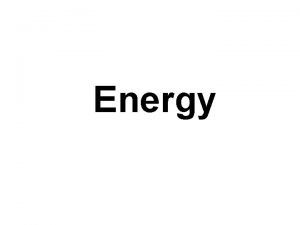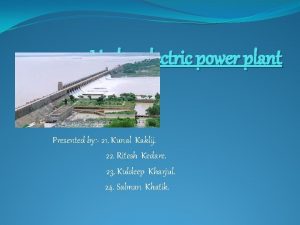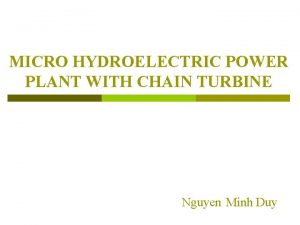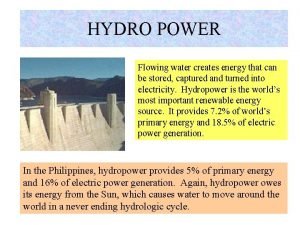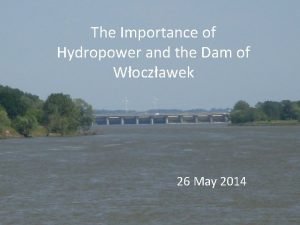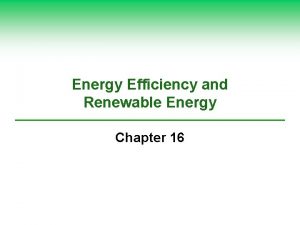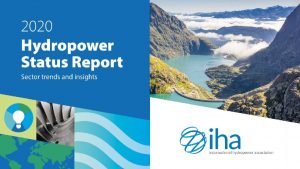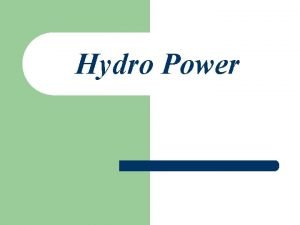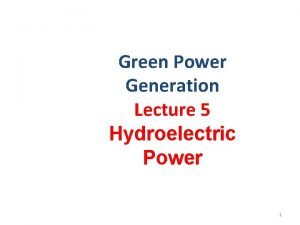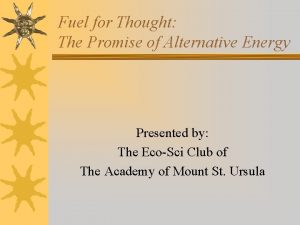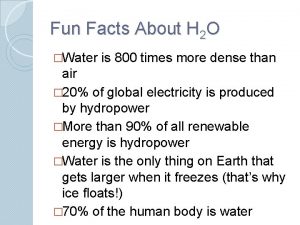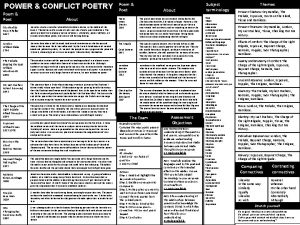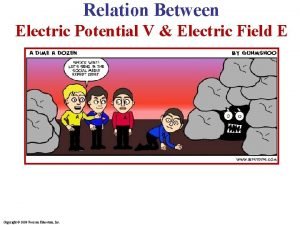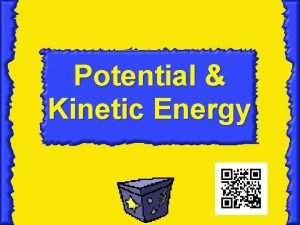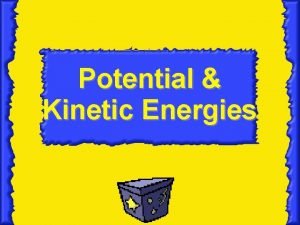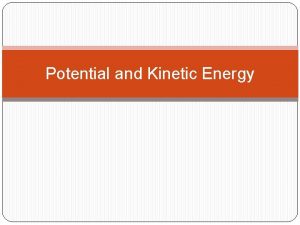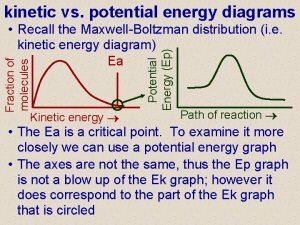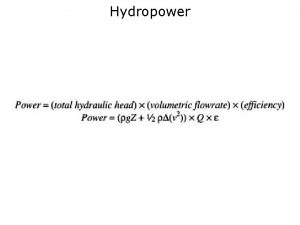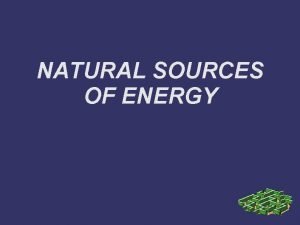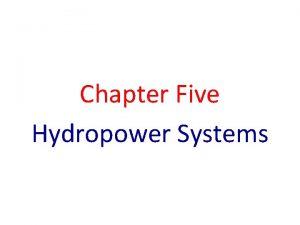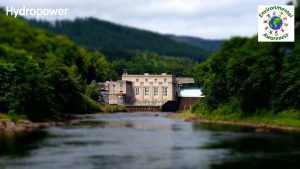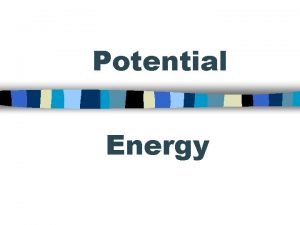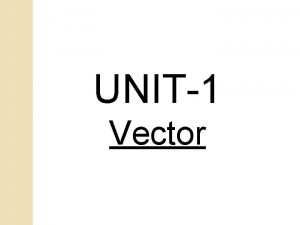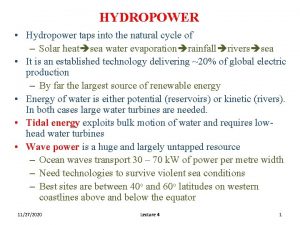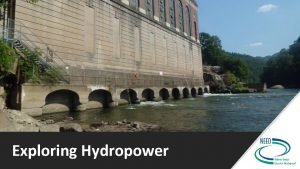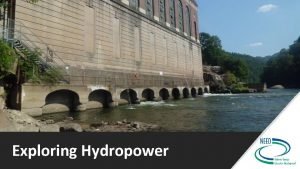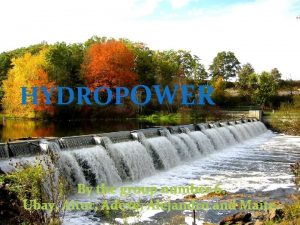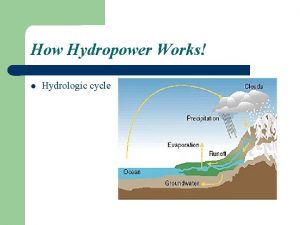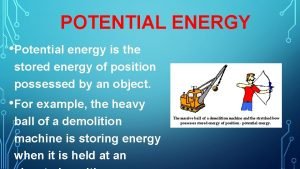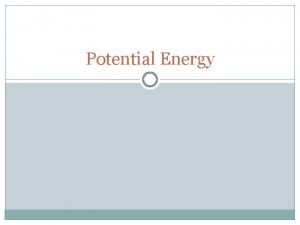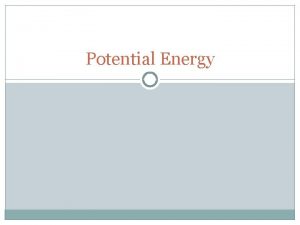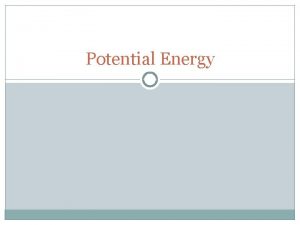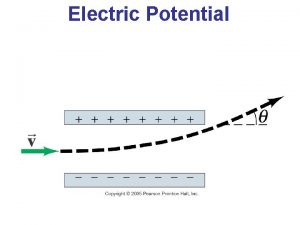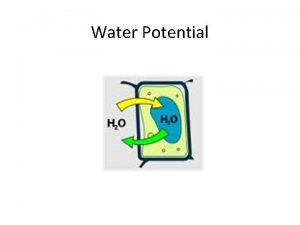Hydropower Engineering Unit1 Energy ResourcesPlanning and Potential Presented



























































- Slides: 59

Hydropower Engineering Unit-1 Energy Resources-Planning and Potential Presented by, Mr. Ankit S. Gujrathi

UNIT-I Energy Resources – Planning and Potential • • • Power resources – Conventional and Nonconventional, Need and advantages, Overview of World Energy Scenario, energy and development linkage, Environmental Impacts of energy use, Green House Effect, Trends in energy use patterns in India, Hydropower development in India, Hydropower potential.

What is Energy ? Energy classified as: 1. Primary energy & secondary energy. 2. Commercial & non commercial energy. 3. Renewable & non renewable energy.

Primary energy: Primary energy refers to all types of energy extracted or captured directly from natural resources Secondary energy: Primary energy is transformed in energy conversion process to more convenient forms of energy such as electricity, steam.


Commercial & Non Commercial Energy Non-Commercial Energy v. Energy available in the market for definite price is known as commercial energy. v. Electricity v. Coal v. Oil v. Natural gas v Any kind of energy which is sourced within a community & it’s surrounding area, & which is not normally traded in commercial market is termed as non-commercial energy. v Firewood & agro waste v Solar energy v Animal power v Wind energy v Cattle dung

Renewable & Non-Renewable Energy Renewable energy: Non-Renewable energy: energy obtain from natural resources & are essentially inexhaustible can not be produce, grown, replenished & are consumed most faster rates than nature can create them

1. Coal There are four types of coal 1 Anthracite 30, 000 KJ/Kg and above 2 Bituminous 18, 300 -29, 000 KJ/Kg 3 Lignite 8, 300 -25, 000 KJ/Kg 4 Peat 5, 500 - 14, 300 KJ/Kg

The current energy scenario Global 1. Coal : ØReserves : 826 billion tonnes. Ø Estimated life : 200 years. Ø Location : reserves found in around 70 countries. The biggest coal reserves are in USA, Russia , China, Australia, India.



The current energy scenario Global 2. Oil : ØReserves : 1258 billion barrels 60% (Middle east) ØEstimated life : ü 15 years. (Non-middle east) ü 80 years. (Middle east) ØLocation : Middle east & Non-middle east • Total production 84, 789, 040. 81 barrels/day • Total consumption 85, 085, 664 barrels/day




The current energy scenario Global 3. Natural gas : ØReserves : 185 trillion cubic meters 60% (Middle east) ØEstimated life : 60 years. ØLocation : Russia, Qatar, Iran, UAE, Saudi Arabia • Total production 84, 789, 040. 81 barrels/day • Total consumption 85, 085, 664 barrels/day




The current energy scenario India Sr. no. 1. 2. 3. Type of fuel Reserve in India Coal 58. 6 Billion tonnes Oil Natural gas 5. 8 Billion barrel 1. 09 trillion cubic meter % sharing in world reserve 7. 1 0. 5 Estimated life (R/P) 114 Years 20 Years 36 Years Location Chassisgarh, Orisa, Jharkha nd, West Bengal. Bombay high, Upper Assam, Cambay, Krishna. Godavari Basin. Gujarat, Assam, Nagaland. Primary energy consumption of our country 55 % 31 % 8. 6 %

World’s Energy Consumption

World’s per capita energy consumption

Sector wise Energy Distribution


Indian Energy Scenario



Electric energy supply

Conventional (Non-Renewable) Energy Sources • • • Coal Oil Natural Gas Nuclear Hydroelectric


Coal Based Steam Power Plants • Advantages 1. Can be located near the load center 2. Transmission losses are comparatively less 3. Fuel is cheaply available 4. Less initial cost • Disadvantages 1. Serious pollution and ecological hazards are associated 2. More thermal losses occurs during starting and stop of plant 3. Low plant efficiency 4. Requires complicated equiments.

Oil and Gas Power Plants

Oil and Gas Turbine Power Plants • Advantages 1. Ease of fuel transportation 2. More efficient 3. Can be built almost anywhere 4. Requires less space • Disadvantages 1. Polluting harmful gases such as Sox, Nox, Oxides of Carbon. etc 2. Fuel is expensive 3. Production and import of fuel is politically charged issue

Hydro-Electric Power Plant


Hydro-Electric Power Plants • Advantages 1. Clean source of energy 2. Economical and cheapest source of energy 3. Greater life expectancy 50 -100 years. 4. Reliable source energy • Disadvantages 1. High initial cost 2. Non availability of suitable sites 3. More transmission losses 4. Susceptible to regaries of nature such as draught

Nuclear Power Plants

Nuclear Power Plants • Advantages 1. Clean source of energy 2. Highly concentrated source of energy 3. No Air pollution 4. Small quantity of fuel is required • Disadvantages 1. Problem of radioactive waste is still unsolved 2. High cost of fuel 3. Mining and purifying of nuclear fuel is not a very clean process 4. Safety issues.


Non- Conventional (Renewable) Energy Sources • • • Solar Energy Wind Energy Biomass Geothermal OTEC, etc.

Advantages of Non-Conventional sources of energy over Conventional • Advantages 1. Clean source of energy and does not pollute the environment 2. Available almost entire year worldwide 3. Generation cost is almost negligible 4. Helpful in remote areas where still electricity is not reached • Disadvantages 1. Initial investment is high 2. Production is highly affected by weather condition 3. Efficiency of plants is quite less.

World’s Renewable Energy Scenario








Global Warming Increase in Earth’s temperature in last two decades

What is Green House Effect? Greenhouse Gases CO 2 Methane Nitrous oxide Fluorinated compounds Since industrial revolution, atmospheric concentrations of carbon dioxide increased 30%, methane more than doubled, nitrous oxide risen by 15%. These increases have enhanced the heat-trapping capability of the earth’s atmosphere

Green House Gases • CO 2 - (55% greenhouse effect)- Primarily from combustion of carbon-containing fuels (fossil fuels). • CFCs- 24 % of warming (R-11 and R-12: 17% and other CFCs: 7%). • Methane- (15% of warming) – Some “natural” biological emissions, such as ruminant animal flatulence and “releases” from termites, but these are enhanced by man’s activities (farming, logging). Some sources are purely manmade, such as unburned methane in natural gas combustion and gas line leaks (huge leaks in Russia). • Compared to a CO 2 molecule, one CH 4 molecule has 25 times the global warming potential (GWP) and one R-12 molecule has 21, 000 times the GWP!

Hypdro. Power in India • • • 7 th Largest Hydro-power producing country in the World. Total Installed Capacity- 44, 595 MW( April 2017) Its contributes 13. 5 % of Indias Energy Consumption. Additional 4380 MW small hydro projects adds 1. 3% India’s Hydropower Potential= 1, 48, 701 MW India’s first Hydro Electric Power Plant- Darjleeng(1898) and Sivasamudram(1902).



Hydropower Potential


Legislation/act/ initiatives Key features Hydropower Development Policy, 1998 • Established a power development fund by levy of cess on electricity consumed 50, 000 -MW initiative, 2003 • Prepared a preliminary feasibility report and detailed project report of hydroelectric schemes in 16 states National Electricity Policy, 2005 • Addressed the issues of long • Emphasised the -term financing of hydel development of large-scale projects and provided hydropower projects guidelines for centre-state participation in the development of hydel projects Mega Power Projects Policy, 2008 • Awarded all hydel projects with a capacity above 500 MW the status of a ‘mega power project’ (qualification relaxed to 350 MW for projects in the northeast region) • Transferred the subject of hydropower development up to 25 MW from the Ministry of Power to the Ministry of New and Renewable Energy • Extended the benefit of a 10 -year tax holiday to the projects identified in the policy , with no customs duty on imports of equipment, etc.

Legislation/act/ initiatives Key features National Hydro Power Policy, 2008 • Replaced the Hydro Power Policy, 1998 • Provided impetus to hydropower development and emphasised the need for increased private sector participation in the hydropower sector • Aimed at quickly harnessing India’s balance hydroelectric potential by ensuring improved financial viability of hydel projects Central Electricity Regulatory Commission (CERC) (Ancillary Services Operation) Regulations, 2015 • To restore and maintain the frequency of electricity supply at desired levels by providing commercial incentives for both ramp up and backdown of ancillary services • Opened a new market for power generation, especially hydropower, given the ability of hydro schemes to provide ancillary support. National Tariff Policy, 2016 • Underlined the norms for ancillary services and also gave rights to the CERC to introduce the norms and frameworks for ancillary services necessary to support grid operations, including the method of sharing of charges • Provided exemption to the hydropower sector from competitive bidding till 2022
 Slidetodoc.com
Slidetodoc.com Hydropower engineering courses
Hydropower engineering courses Hydropower energy
Hydropower energy Electric potential units
Electric potential units Peelectric
Peelectric Electric potential vs electric potential energy
Electric potential vs electric potential energy Advantages and disadvantages of hydroelectricity
Advantages and disadvantages of hydroelectricity Potential energy summary
Potential energy summary Kinetic energy and potential energy formula
Kinetic energy and potential energy formula Formula of potential energy
Formula of potential energy Conservation of mechanical energy
Conservation of mechanical energy How hydropower works
How hydropower works Flowing water creates energy that can be captured
Flowing water creates energy that can be captured Importance of hydropower
Importance of hydropower Hydropower system
Hydropower system Advantages and disadvantages of dam
Advantages and disadvantages of dam Hydroelectricty
Hydroelectricty Hydropower
Hydropower Hydropower equation
Hydropower equation Facts about hydropower
Facts about hydropower Hydropower fun facts
Hydropower fun facts Formula for energy
Formula for energy Gravitational and kinetic energy
Gravitational and kinetic energy What is the definition of chemical potential energy
What is the definition of chemical potential energy Mechanical energy examples
Mechanical energy examples Gravitational potential energy vs kinetic energy
Gravitational potential energy vs kinetic energy Potential vs kinetic energy
Potential vs kinetic energy Graded potential
Graded potential Equipotential lines
Equipotential lines Osmosis equation
Osmosis equation Market potential and forecasting
Market potential and forecasting Electric potential inside non conducting sphere
Electric potential inside non conducting sphere Potential due to an electric dipole
Potential due to an electric dipole Electric potential
Electric potential Energy energy transfer and general energy analysis
Energy energy transfer and general energy analysis Energy energy transfer and general energy analysis
Energy energy transfer and general energy analysis How to find pressure potential
How to find pressure potential Osmotic potential vs water potential
Osmotic potential vs water potential Neuronal pool
Neuronal pool Graded potential vs action potential
Graded potential vs action potential Graded potential vs action potential
Graded potential vs action potential Saltatory conduction
Saltatory conduction Osmotic potential vs water potential
Osmotic potential vs water potential Sources of biopotential
Sources of biopotential Transmission across a synapse
Transmission across a synapse Neuromuscular junction ach
Neuromuscular junction ach Axon hillock
Axon hillock Action potential resting potential
Action potential resting potential Jekyll and hyde setting
Jekyll and hyde setting Theme of hate in romeo and juliet
Theme of hate in romeo and juliet How is power presented in ozymandias and london
How is power presented in ozymandias and london Ozymandias and my last duchess comparison
Ozymandias and my last duchess comparison Cause and effect structure example
Cause and effect structure example Relation between e and v
Relation between e and v Kinetic and potential energy
Kinetic and potential energy Kinetic and potential energy
Kinetic and potential energy Kinetic and potential energy
Kinetic and potential energy Examples of kinetic energy
Examples of kinetic energy Potential energy
Potential energy Kinetic energy diagram
Kinetic energy diagram


